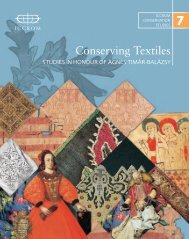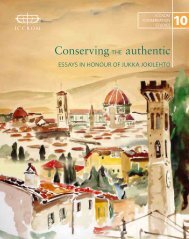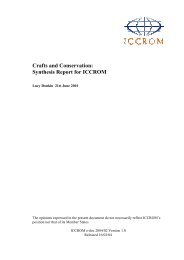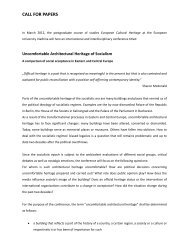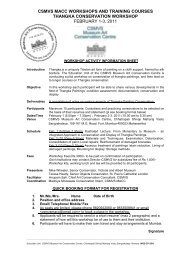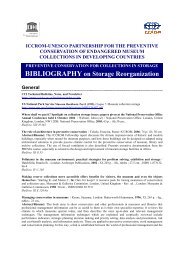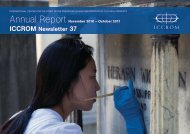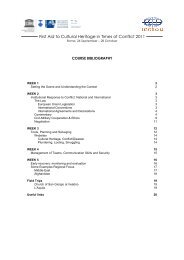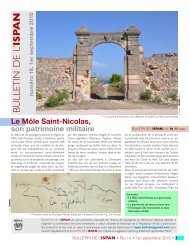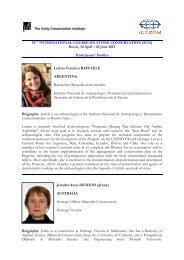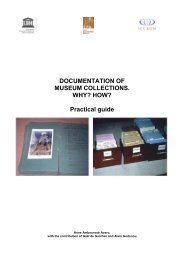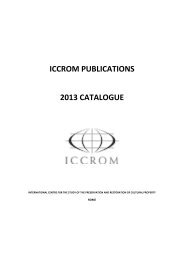part 1 - Iccrom
part 1 - Iccrom
part 1 - Iccrom
Create successful ePaper yourself
Turn your PDF publications into a flip-book with our unique Google optimized e-Paper software.
MEASURING HERITAGE CONSERVATION PERFORMANCE<br />
6th International Seminar on Urban Conservation<br />
of protection of the buildings which might reach the<br />
status of ruin.<br />
5.2.3. Historical Protection Areas - APH<br />
Historical protected areas were defined and<br />
demarcated as a protective regulating instrument.<br />
Among the instruments devised to protect and/or<br />
realize the city’s built, environmental and landscape<br />
heritage, the Historical Protection Areas (APH) and<br />
the Ecological and Environmental Protection Areas<br />
(APEA) are worth focusing on. These, added to the<br />
urban indexes proposed by the new urban code,<br />
deal with the conservation of the property and<br />
preservation of the landscape in a comprehensive<br />
way. Those sectors in the urban fabric containing<br />
historically and/or architecturally valuable buildings<br />
or <strong>part</strong>icular conditions in their construction,<br />
in the morphology of the whole building and in the<br />
composition and/or character of their public spaces<br />
need to be protected.<br />
Several management instruments are articulated<br />
to ensure urban landscape conservation:<br />
• Inventory and indexing of heritage<br />
property.<br />
• Degrees of construction protection for<br />
inventoried property.<br />
• Construction conservation measures and<br />
potential transformations of use.<br />
• Specific urban indicators for the lots<br />
involved.<br />
• Conditions for design, materials and<br />
installation of elements on the façade.<br />
Numerous APHs have been established in the<br />
central areas — Pichincha, Oroño, Paseo del Siglo<br />
— and in the once neighboring towns, today residential<br />
districts: Pueblo Alberdi, Saladillo and Fisherton<br />
(currently in progress) to enable the protection<br />
of the whole complex beyond the individual works.<br />
Disclosure strategies and citizens’ <strong>part</strong>icipation.<br />
Disclosure is an instrument that permits the average<br />
person to get acquainted with heritage protection<br />
actions. The following disclosure strategies<br />
of the direct protection instruments described —<br />
inventories and APH — intend to involve the average<br />
person in heritage conservation:<br />
• Urban rides related to the heritage property<br />
that originates the APH.<br />
• Publication of a catalogue containing the<br />
urban routes.<br />
The specialist group I belong to, representing Universidad<br />
Nacional de Rosario in the Agreement<br />
with the Municipality of Rosario, has just elaborated<br />
a project called ‘Agreed — Shared-Heritage’, which<br />
permits the active <strong>part</strong>icipation of the average person<br />
in the appraisal of heritage.<br />
Once the inventory of the city areas is proposed,<br />
mechanisms are established to disclose its progress<br />
so that the citizens can to voice their opinion. New<br />
heritage elements which are especially meaningful<br />
to the inhabitants, and which after the initial<br />
historical/architectural/documentary appraisal<br />
contributed by the specialists were not included in<br />
the inventory, may be incorporated. Including the<br />
directly involved social actors’ opinion helps to<br />
verify inventory relevance.<br />
This project’s <strong>part</strong>icular objectives:<br />
• To communicate to the citizens the catalogue<br />
of weighted works as city heritage<br />
corresponding to the districts.<br />
• To encourage rediscovery of significant<br />
works in the area which determine the<br />
identity of the urban landscape.<br />
• To enable the contribution of the citizens<br />
in the recognition and appraisal of urban<br />
cultural heritage.<br />
• To establish a space of citizen <strong>part</strong>icipation<br />
in the actions involving local heritage.<br />
This initiative becomes an inventory validation<br />
tool. This will permit appreciation and rightsizing<br />
of the Heritage surveyed as a group elaboration by<br />
all the actors, specialists and general public, who<br />
determine the urban fact, from a new qualitative<br />
interpretation that includes the appraisal arising<br />
from symbolic heritage (intangible heritage) contributed<br />
to by the experiences that create urban culture<br />
in time. This project encourages citizens to discover<br />
and appraise the heritage that characterizes,<br />
defines, and identifies the place where they live. We<br />
consider that feeling a <strong>part</strong> of it all involves citizens<br />
in its conservation.<br />
Instruments for Monitoring and Assessment.<br />
A strategy must be formulated to assess the new<br />
code actions’ effectiveness, especially in the central<br />
area, in relation to the substitution of heritage property<br />
(for example, by discouraging tall buildings),<br />
Rainero, C. 2012. How to register memory? Documentation, recording, archiving and preservation of intangible cultural heritage in<br />
Venezuela. In Zancheti, S. M. & K. Similä, eds. Measuring heritage conservation performance, pp. 59-66. Rome, ICCROM.<br />
64



